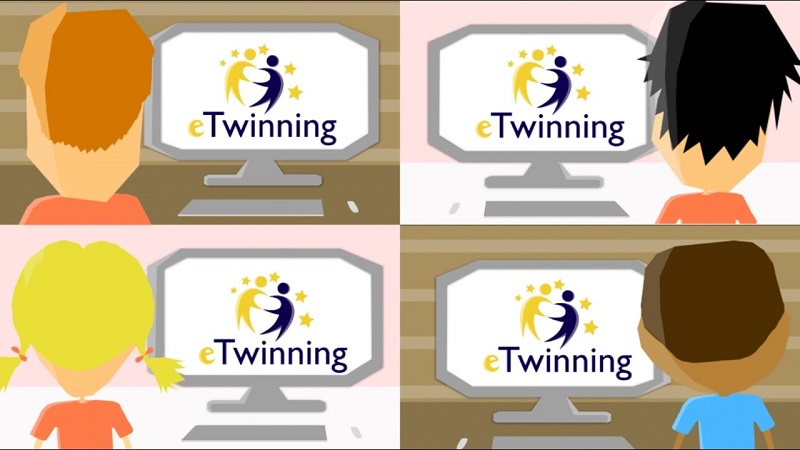November 1, 2020
Using Tech to Enable Global Collaboration; a small school perspective

WHY?
Cape Town/South Africa, 11 148km. Illinois/USA, 6880km. Dubai/United Arab Emirates, 5062 km. Milan/Italy, 2472 km, Helsinki/Finland, 802km, Arctic Circle, 30km. Our school is a really tiny upper secondary school, situated in a place that for many would be in the middle of nowhere, in a small rural village in Lapland, Finland. We have very little cultural diversity among our students and staff, the opportunities to speak a foreign language other than Swedish in an authentic environment is limited. One of the goals of upper secondary education in Finland is to provide students with the skills and competencies needed to be active, caring, tolerant and responsible global citizens who understand the benefits of multilateral collaboration in building a good future. For us reaching this goal without having access to the technology that we have today would be difficult.
Small, financially limited and remote doesn’t mean backward and isolated. Our school has been a 1:1 iPad school since 2013, the Ministry of Education has awarded us an eTwinning School-label, which means we are recognised as leaders in digital practice, we are considered to be innovative and we utilise creative approaches to pedagogy and promote collaborative learning methods with staff and students. We try to provide all our students with international learning experiences or opportunities to participate in global projects. This is a goal that requires a shared vision and strategy, flexibility, hard work, passion, time and also some money. If global collaboration is something we value, there should be resources earmarked for that purpose.
My opinion as a school leader is that global collaboration and international experience is so important to our students that if given an opportunity, we should always try to make room for it in our often very busy and fixed schedules. There are so many ways to deliver lessons and support learning digitally that giving up a couple of lesson hours in any subject or course is not the end of the world. Opportunities to collaborate often arise impromptu so planning them into the annual timetable is not always possible.
WHAT?
Teachers and students around the world are extremely busy and finding time to collaborate on something that is not linked to the curriculum is difficult. This is why finding a cross-curricular topic that can be embedded into different national or local curricula is always a good starting point for a global project. In Finland upper secondary schools are also allowed to create local courses, so if our students participate in an international project they can earn academic credits for it whatever the content of that project is. During the seven years our learning environment has been digital, we have taken part in numerous really lovely international projects and collaborative activities enabled by technology. Today our global education mainly consists of three different types of activities: 1) international guest speakers and other virtual visitors 2) eTwinning- or Erasmus-projects with partners found in the digital eTwinning-community 3) (Erasmus-) projects with partners found in the Apple Distinguished Educators -network. Before the pandemic restrictions we also used to host job shadowing teachers from all over Europe and took our students to language learning excursions in the UK and Germany or Austria.
HOW?
Virtual visitors
A year ago our students had a unique opportunity to interview the 86-year-old South-African anti-apartheid activist Denis Goldberg via Skype. The warm way this incredible man answered our students’ questions about his life in prison and his dedication to helping young people with art had such an impact on our students (and staff). No history, social studies, psychology or language lesson in the world could have achieved the same. I am sure we all will remember these 60 minutes for the rest of our lives.
Arranging whole-school guest speaker lessons like this is the simplest way of using tech to bring the world to our classrooms. It only takes an internet connection, a device for making the live connection and some kind of a sound system so that everyone in the room can hear the guest and vice versa. We usually only use an iPad or a Mac connected to external loudspeakers and a data projector. We don’t have any conference audio system yet and so far the tech has worked well enough. In a remote setting this would be even easier to arrange by inviting the guest to our video conference meeting. Without technology our students would have missed amazing authentic and interactive lessons, e.g. what it is to be a Muslim, American cultures and building cross cultural competencies and what it is like to study and work in the UK. There have been some funny misunderstandings as well. I had arranged a chat for my first year students (who are 16 years old) with a group of first year students in Norway. When we met on FaceTime we realised the Norwegian first year students were a bit younger than expected; it was literally their first year at school! The chat turned out to be different from what we had planned, but still, it was a really nice experience for everyone.
Anyone reading this article is welcome to visit our classrooms virtually! There’s always something to share and learn from each other.
RECOMMENDED: https://global-edtech.com/category/community/
eTwinning-projects
eTwinning-projects are projects that can be managed on the digital eTwinning-platform open to all European schools (registration needed). The platform has a virtual secure workspace with several inbuilt collaborative tools for planning the project and even chat and video conferencing tools. Learning to navigate the platform can be a bit tricky, but this is a great alternative when we work with schools that don’t have access to personal devices. Last year our students participated in a cross curricular eTwinning-project with students from Denmark. The topic was Empathy and Social Media and we embedded the lessons in our English, media literacy and religion courses. Since eTwinning-projects are 100% digital, they are easy to manage even if students are working from home. Students have access to the tools in the workspace once the teacher has registered them in the project.

Projects with other iPad-schools
Our learning environment is almost 100% digital, we use iPads in all steps of our digital workflow from sharing material to creating content, communication, collaboration, feedback, evaluation and assessment. This is why the global projects we have with other Apple Distinguished Educators and their students are the ones in which we use technology the most and also in the most versatile and creative way. We plan and manage the projects in shared Numbers documents, use FaceTime to connect, Kahoot!, Socrative and Quizlet for ice breaking activities and use collaborative features in Pages, Keynote and Numbers to work on the same document. GarageBand, Clips, iMovie and Keynote are used for creative work, Facebook Live is used to stream activities to a wider audience and finally Twitter and Instagram to share the process with the world. We’ve learned that even if our students don’t always have a common language, technology has a way of connecting them. When students of different ages or with different cultural and linguistic background use the same working methods and apps, understanding each other becomes easier (the Translate app can help too!).
We’ve had amazing projects with ADE-partners around Europe! We’ve trained digital leaders together, worked on digital storytelling, studied European epic stories, written children’s stories together and taken children on a virtual tour through Lapland. In some of these projects (Erasmus+ mobility) we’ve been able to meet live as well. That has been amazing and has resulted in lifelong friendships.
Future plans
During the past eight months teachers and students around the world have been under tremendous pressure. We have all done an amazing job, teachers have worked 24/7 to make sure our students get the best education despite school closures and other restrictions. We’ve tried to take care of each other, make everyone feel safe, heard and seen. Global collaboration has probably not been at the top of our priority lists.
In uncertain times such as this, it is more important than ever to look forward and try not to get stuck in an “on hold”-phase. There’s a need for a global view and by sharing experiences, a collaborative projects where student learn about the world can be empowering and engaging. Even if we are physically distanced we can be digitally connected.
Sari Lantto, Headteacher/Ylitornio upper secondary school, Finland
Apple Distinguished Educator/Class of 2015















0 Comments
Trackbacks/Pingbacks